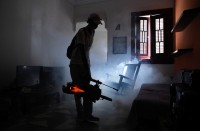WASHINGTON, United States (AFP) — Building standards need to undergo a “paradigm shift” to better protect against airborne diseases, a group of experts said Thursday, drawing on hard-won lessons from the Covid pandemic.
Future building designs must incorporate increased ventilation and air-cleaning measures, including filtration and disinfection using both filters and ultraviolet devices, they wrote in the journal Science.
This comes as accumulating data suggest that tiny particles containing the coronavirus that are released by breathing, speaking, sneezing, and coughing are a major driver of Covid spread.
The 39 experts, who include some of the world’s foremost environmental engineers, noted that there was a marked disparity in the way governments regulated food safety, sanitation and drinking water compared to airborne pathogens.
Aerial transmission of diseases wasn’t recognized for a long time, the authors wrote, because “it is much harder to trace airborne infections,” while food and water contamination nearly always come from an easily identifiable source.
“Airborne studies are much more difficult to conduct because air as a contagion medium is nebulous, widespread, not owned by anybody and uncontained.”
What’s more, “most modern building construction has occurred subsequent to a decline in the belief that airborne pathogens are important” and therefore lack design and construction elements to mitigate the risk.
“The ventilation rate will differ for different venues according to the activities conducted there,” they said, with higher rates required for exercising in gyms compared to resting in movie theaters.
Rates will also have to differ depending on the type of pathogen that is currently prevalent, given that emission rates and infectious doses vary.
It is also important to add control systems to adjust energy use and prevent air pollution from outside contaminants indoors, the paper added.
The authors called for global indoor air quality standards (IAQ) led by the World Health Organization and the development of comprehensive standards by national governments and professional bodies.
They also called for wide use of monitors, so that members of the public are aware of the air quality in the indoor spaces they share.
“A paradigm shift is needed on the scale that occurred when Chadwick’s Sanitary Report in 1842 led the British government to encourage cities to organize clean water supplies and centralized sewage systems,” they concluded.
© Agence France-Presse








